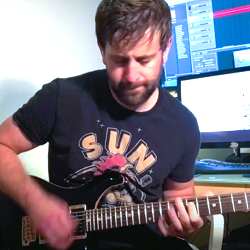Building Guitar Interval Exercises from Stacked Thirds

In this lesson, we’ll look to build guitar exercises based off patterns we’re likely to play when we’re not just working on strength and dexterity.
I’ll show you how to use stacked thirds (triads) to build exercises that sound musical and will be relevant outside of exercise patterns.
To do this, we’ll start with a crash course in guitar intervals.
The easiest way to understand intervals in a fretboard context is to think of them as the building blocks of chords and scale shapes. Measured in semitones (one fret equals one semitone), intervals give us the space between any two notes on our fretboard.
Each interval has two parts:
- 1. The tonic (or “root”)
- 2. The interval of said tonic.
Simple, right?
The distance between the tonic and the interval gives us the, well...interval.
For example, say we have the following root note:
If we know our fretboard notes, we can tell right away that this is an E. Let’s add a second note to the tab:
We now have an interval where two frets separate the two notes. Referring to our interval chart, we can identify the interval as a major second.
That’s your crash course in intervals.
What we’re going to do now is develop a series of interval-based exercises that will help us accomplish three things:
1. Build strength, speed and dexterity
2. Begin to hear and memorize common triadic patterns
3. Become more familiar with the third and fifth intervals.
Building Triads (Stacked Thirds) Out of the C Major Scale
For these exercises, we’re going to create what is called a sequence, meaning we’ll establish an interval pattern that repeats at higher and/or lower pitches. It sounds tricky but is quite simple.
We’ll use the C major scale as a grid on which to build the interval patterns.
We need to find what are called diatonic triads, which requires a few steps. First, plot the C major scale on a tab sheet:
FYI: The notes of the C major scale are C - D - E - F - G - A - B - C
Now we need to stack a third and fifth interval on top of each root note, giving us a series of triadic chord shapes.
From our cheat sheet we know that the major third spans four semitones while a perfect fifth spans seven. If we add the third and fifth to each note in the C major scale, we get the following tab:
Each chord you see in the tab sheet is a triad giving us our long-awaited collection of stacked thirds based on the C major scale. Further, each chord is a basic major shape, without any additional intervals.
If we wanted to add some complexity we could add intervals to the chord shapes. For example, add a minor or major seventh interval (10 or 11 semitones) to the same shape to give us a B7 chord.
This is how you could build out more advanced chord patterns if you wanted more of a challenging exercise.
For the purpose of illustration, we’ll stick with the major triadic shape.
Now that we have it in place, we can arpeggiate the pattern out into our first exercise:
Further, we can take the exercise and start to break it up into different pieces that target specific sections of the fretboard. We’ll also single out particular chords (arpeggios) and sequence them over a series of high and low pitches.
Let’s start on the eighth fret and move up:
Repeat the process with our root on the fifth string:
And once more with our root on the fourth string:
The variation and sequence of the actual exercise is now up for creative interpretation. How to arrange and move the patterns is largely up to you and doesn’t necessarily have to following a set-in-stone method.
Let’s review the process so we can repeat it with a different scale:
1. Choose a key and a scale (C major, E major, etc.)
2. Plot the seven notes (scale degrees) of that scale on a tab sheet
3. Add the third of the root
4. Add the fifth of the root
5. Sequence those patterns to build guitar interval exercises.
This gives us a great tool for not only improving our physical strength but also our mental strength as a music theorist.
Because you’re building exercises based on actual patterns that you’ll see repeated in a lot of different musical situations. Thus the exercises we come up with are functional, applicable and made up of patterns that we’ll use when we’re not just exercising our fingers.
Bobby Kittleberger is the founder and editor of Guitar Chalk. You can get in touch with him here, or via Twitter.
Flickr Commons Image Courtesy of Kmeron
Get The Pick Newsletter
All the latest guitar news, interviews, lessons, reviews, deals and more, direct to your inbox!
Bobby is the founder of Guitar Chalk, and responsible for developing most of its content. He has worked with leading guitar industry companies including Sweetwater, Ultimate Guitar, Seymour Duncan, PRS, and many others.
“There are so many sounds to be discovered when you get away from using a pick”: Jared James Nichols shows you how to add “snap, crackle and pop” to your playing with banjo rolls and string snaps
Don't let chord inversions bamboozle you. It's simply the case of shuffling the notes around








![Joe Bonamassa [left] wears a deep blue suit and polka-dotted shirt and plays his green refin Strat; the late Irish blues legend Rory Gallagher [right] screams and inflicts some punishment on his heavily worn number one Stratocaster.](https://cdn.mos.cms.futurecdn.net/cw28h7UBcTVfTLs7p7eiLe.jpg)


